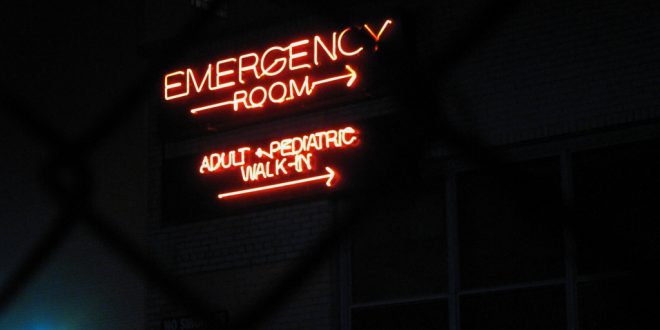Many people know that the intense and traumatic experiences soldiers face can result in posttraumatic stress disorder (PTSD)—as can civilian traumas, such as assaults or car crashes. However, many people may not realize that caring for traumatically injured patients can have the same psychological effects as the trauma itself. This is known as secondary traumatic stress (STS). Unlike traditional PTSD where one must face an actual or perceived threat to his or her safety to be diagnosed, STS arises from being exposed (often repeatedly) to the traumatic experiences of others. Who in the healthcare industry is at risk for STS? By in large, it is anyone who cares for trauma patients. Between 15 and 21% of social workers and psychologists working with trauma patients experience STS (Bride, 2007; Cieslak et al., 2013; Choi, 2011) But what about clinicians on the frontline of healthcare, emergency medicine (EM) clinicians?
Because EM providers often see patients at their worst and have to work against their natural sleep cycles, care for numerous patients, and make critical decisions—often with little time or information about the patient—they are clearly under a great deal of stress. This is in addition to the fact that EM clinicians already face the highest level of burnout in healthcare (Parks, 2017). Although some studies have examined STS in EM clinicians, they either used small or potentially biased samples (Dominguez-Gomez & Rutledge, 2008; Hatcher, Bride, Oh, King, & Catrett, 2011), and none have examined STS in physician-level providers. However, one recent study by Jacob W. Roden-Foreman and his colleagues (2017) appears to have avoided such issues.
In their study of 118 physician-level EM providers from 10 hospitals in Texas, Roden-Foreman and his team found that 13% of EM clinicians reported experiencing all of the symptoms of STS in the last week and 34% reported feeling at least one of the symptoms. This rate was substantially lower than what the researchers expected to see and could be the result of a “self-selection process where EM providers more affected by their patients remove themselves from the field.” However, the researchers also posit that because EM providers don’t typically see their patients after they leave the emergency department, there isn’t a long period of emotional bonding between EM providers and their patients. As a result, similar psychological syndromes that are very similar to STS but rely on long-term empathic engagement, such as vicarious traumatization or compassion fatigue, are less likely to be present in EM clinicians. This may account for the lower-than-expected rate and be the reason that studies examining other specialties found higher rates.
The researchers also looked at potential risk factors for and protective factors against STS. They found that EM providers who had also suffered a trauma were nearly 50% more likely to experience STS at clinical levels and this risk increased for each traumatic event the providers suffered. But it wasn’t all bad news, the researchers also found that a psychological trait called resilience could significantly decrease providers’ odds of experiencing STS. Best of all, unlike personal history, resilience is something that can be changed.
The researchers examined several other risk and protective factors, read the full paper below.
Read the full paper: Roden-Foreman, J. W., Bennett, M. M., Rainey, E. E., Garrett, J. S., Powers, M. B., & Warren, A. M. (2017). Secondary traumatic stress in emergency medicine clinicians. Cognitive Behaviour Therapy, 1-11. doi:10.1080/16506073.2017.1315612

References
- Bride, B. E. (2007). Prevalence of secondary traumatic stress among social workers. Social Work, 52, 63–70. https://doi.org/10.1093/sw/52.1.6310.1093/sw/52.1.63
Choi, G. Y. (2011). Secondary traumatic stress of service providers who practice with survivors of family or sexual violence: A national survey of social workers. Smith College Studies in Social Work, 81, 101–119. https://doi.org/10.1080/00377317.2011.543044 - Cieslak, R., Anderson, V., Bock, J., Moore, B. A., Peterson, A. L., & Benight, C. C. (2013). Secondary traumatic stress among mental health providers working with the military: Prevalence and its work- and exposure-related correlates. The Journal of Nervous and Mental Disease, 201, 917–925. https://doi.org/10.1097/NMD.0000000000000034
- Dominguez-Gomez, E., & Rutledge, D. N. (2008). Prevalence of secondary traumatic stress among emergency nurses. Journal of Emergency Nursing, 35, 199–204. https://doi.org/10.1016/j.jen.2008.05.003
- Hatcher, S. S., Bride, B. E., Oh, H., King, D. M., & Catrett, J. F. (2011). An assessment of secondary traumatic stress in juvenile justice education workers. Journal of Correctional Health Care, 17, 208–217. https://doi.org/10.1177%2F107834581140150910.1177/1078345811401509
- Parks, T. (2017, January 31). Report reveals severity of burnout by special. American Medical Association Wire, Retrieved from https://wire.ama-assn.org
- Roden-Foreman, J.W., Bennett, M.M., Rainey, E.E., Garrett, J.S. , Powers, M.B., & Warren, A.M. (2017). Secondary traumatic stress in emergency medicine clinicians. Cognitive Behaviour Therapy. Advance online publication. https://doi.org/10.1080/16506073.2017.1315612
Photo by: Rob Nguyen
 Cognitive Behaviour Therapy A peer reviewed, multidisciplinary journal devoted to the application of behavioural and cognitive sciences to clinical psychology and psychotherapy.
Cognitive Behaviour Therapy A peer reviewed, multidisciplinary journal devoted to the application of behavioural and cognitive sciences to clinical psychology and psychotherapy.




